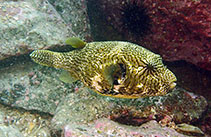| Family: |
Tetraodontidae (Puffers), subfamily: Tetraodontinae |
| Max. size: |
65 cm TL (male/unsexed) |
| Environment: |
reef-associated; marine; depth range 4 - 30 m |
| Distribution: |
Indo-Pacific: East Africa south to Natal, South Africa (Ref. 4919) and east to Samoa, northward to the Ryukyus and western sea of Japan, southward to New Caledonia and Queensland, Australia. |
| Diagnosis: |
Dorsal spines (total): 0-0; Dorsal soft rays (total): 11-12; Anal spines: 0-0; Anal soft rays: 10-11. Body covered with prickles (Ref. 559). Body beautifully colored; black area around anus, black reticulations below pectoral fins (Ref. 4919).
Description: Characterized further by extensive black blotch on belly; head and body covered with small spinules except around mouth, base of fins and caudal peduncle; short snout, length about 7.0 in SL; short and rounded caudal fin, length 4.2-5.1 in SL (Ref. 90102). |
| Biology: |
Occur in clear lagoon and sheltered seaward reefs (Ref. 9710). Solitary (Ref. 90102). Adults usually along deep drop-offs (Ref. 48637). Usually close to shelter. Occur singly (Ref. 9710). Feed on algae, sponges, and benthic invertebrates. |
| IUCN Red List Status: |
Least Concern (LC); Date assessed: 07 June 2011 Ref. (130435)
|
| Threat to humans: |
poisonous to eat |
Source and more info: www.fishbase.org. For personal, classroom, and other internal use only. Not for publication.

